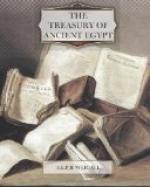The inhabitants are few in number. Most of the males have taken service as cooks, butlers, waiters, and bottle-washers in European houses or hotels throughout Egypt; and consequently one sees more women than men pottering about the villages or working in the fields. They are a fine race, clean in their habits and cheery in character. They can be distinguished with ease from the Egyptian fellahin; for their skin has more the appearance of bronze, and their features are often more aquiline. The women do not wear the veil, and their dresses are draped over one shoulder in a manner unknown to Egypt. The method of dressing the hair, moreover, is quite distinctive: the women plait it in innumerable little strands, those along the forehead terminating in bead-like lumps of bee’s-wax. The little children go nude for the first six or eight years of their life, though the girls sometimes wear around their waists a fringe made of thin strips of hide. The men still carry spears in some parts of the country, and a light battle-axe is not an uncommon weapon.
There is no railway between Aswan and Halfa, all traffic being conducted on the river. Almost continuously a stream of native troops and English officers passes up and down the Nile bound for Khartoum or Cairo; and in the winter the tourists on steamers and dahabiyehs travel through the country in considerable numbers to visit the many temples which were here erected in the days when the land was richer than it is now. The three most famous ruins of Lower Nubia are those of Philae, just above Aswan; Kalabsheh, some forty miles to the south; and Abu Simbel, about thirty miles below Halfa: but besides these there are many buildings of importance and interest. The ancient remains date from all periods of Egyptian history; for Lower Nubia played an important part in Pharaonic affairs, both by reason of its position as the buffer state between Egypt and the Sudan, and also because of its gold-mining industries. In old days it was divided into several tribal states, these being governed by the Egyptian Viceroy of Ethiopia; but the country seldom revolted or gave trouble, and to the present day it retains its reputation for peacefulness and orderly behaviour.
Owing to the building, and now the heightening, of the great Nile dam at Aswan, erected for the purpose of regulating the flow of water by holding back in the plenteous autumn and winter the amount necessary to keep up the level in the dry summer months, the whole of the valley from the First Cataract to the neighbourhood of Derr will be turned into a vast reservoir, and a large number of temples and other ruins will be flooded. Before the dam was finished the temples on the island of Philae were strengthened and repaired so as to be safe from damage by the water; and now every other ruin whose foundations are below the future high-water level has been repaired and safeguarded.




